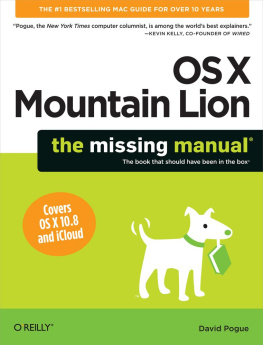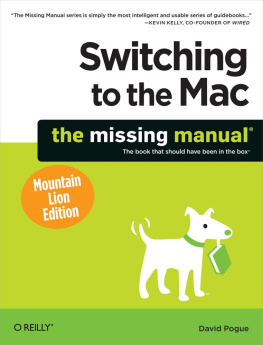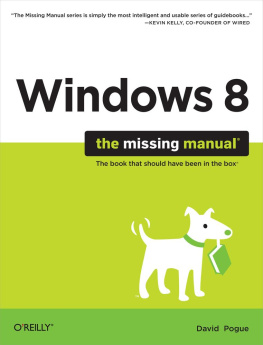Links to his columns and videos await at .
About the Creative Team
Julie Van Keuren (editor, indexer, layout) quit her newspaper job in 2006 to move to Montana and live the freelancing dream. She and her husband, M.H.whos living the novel-writing dreamhave two teenage sons, Dexter and Michael. Email : .
Phil Simpson (design and layout) runs his graphic design business from Southbury, Connecticut. His work includes corporate branding, publication design, communications support, and advertising. In his free time, he is a homebrewer, ice cream maker, wannabe woodworker, and is on a few tasting panels. He lives with his wife and four great felines. Email: .
Acknowledgments
The Missing Manual series is a joint venture between the dream team introduced on these pages and OReilly Media. Im grateful to all of them, and also to a few people who did massive favors for this book.
First of all, I discovered the hard way that Windows 10 is a brand-new operating system; theres very little up-to-date, accurate information about it. My bacon was saved by Waggener Edstroms Greg Chiemingo and his team, who patiently helped dig up answers to the tweakiest questions. The Microsoft team members he corralled to assist included Marcus Ash and Mohammed Samji, and I wouldnt have known what I was talking about without them.
I also owe a debt of thanks to OReillys Nan Barber, who accommodated my nightmarish schedule with grace; and proofreaders/helpers Kellee Katagi, Judy Le, Gretchen Tipps, and Nancy Young.
In previous editions of this book, I relied on the talents of several guest authors and editors; some of their prose and expertise lives on in this edition. They include Mike Halsey, Brian Jepson, Joli Ballew, C.A. Callahan, Preston Gralla, John Pierce, and Adam Ornstein.
Finally, a special nod of thanks to my squadron of meticulous, expert volunteer beta readers who responded to my invitation via Twitter: Robin Chattopadhyay, Justin Higgins, Nora Buckley, Carlos Cordera, Rev. Robert J. Kelley, Lim Thye Chean, Jerry Peek, Joel Taylor, Kasim Hassan, Ann Hyatt Logan, Chris Rauchle, Thomas Kerber, Devin Sijan, Lou Fonolleras, Jon Colt, Cori Culp, Pete Morey, Thabo Zijlstra, Jiayan Xiang, Bob Myrick, Shaun Orpen, Jeff Franklin, and Ralph Sanchez. Theyre the superstars of crowdsourcing, selfless and eagle-eyed, and they made the book a lot better.
Thanks to David Rogelberg for believing in the idea. Thanks, above all, to Nicki, my muse and my love, and the three Poguelets: Kelly, Tia, and Jeffrey. They make these booksand everything elsepossible.
David Pogue
Introduction
Even Microsoft admits it now: Windows 8 was a huge mistake. It was, in essence, two radically different operating systems, superimposed (see ). There was the regular desktop, which worked a lot like the popular Windows 7. And then, lying over it, there was a new, colorful world of tiles and modern typographyI called it TileWorld, since Microsoft didnt have a name for itthat was designed for the new world of touchscreen tablets and laptops.
Unfortunately, the result was two Web browsers, two Control Panels, two mail programs, two ways of doing everything. And, in general, people couldnt stand it.
In hopes of getting as far away from Windows 8 as possible, Microsoft skipped Windows 9 entirely; there never was a Windows 9. But now theres Windows 10.
In this new operating system, Microsoft achieved something rather brilliant: It eliminated the split personality of Windows 8 but managed to retain the touch-friendly features. Just in case, you know, the world moves to touchscreen computers after all.
If youre a PC veteran, then youll recognize Windows 10: Its pretty much Windows 7 with a few new features and nicer typography.
And if youre relatively new to all this, then get down on your knees beside your bed tonight and thank whatever you believe in that you were spared the emotional and mental whiplash of Microsofts changing its mind.
Whats New in Windows 10
The most radical new feature of Windows 10 is that Microsoft doesnt consider it a version of Windows. Instead, its going to be a work in progressa continuously improved, living blob of software. The age of service packsmegalithic annual chunks of updates and patchesis over. Instead, Microsoft intends to fix bugs (there are plenty) and add features continuously via quiet, automatic software releases.
That should make life interesting for you, and miserable for people who write computer books.
Figure 1. Windows 8 and 8.1 offered two radically different environments, mashed together onto the same computer: the standard desktop (top) and TileWorld (bottom).
But you have to start somewhere. So heres the list of new features that came with the first download of Windows 10:
The Start menu . It may have taken four years, but Microsoft finally realized the foolishness and incoherence of the Start screen that, in Windows 8, replaced the Start menu .
In Windows 10, the Start menu is back, and it works pretty much just as it always hasbut the Windows 10 tiles are still here, attached to the right side of the menu ().





















